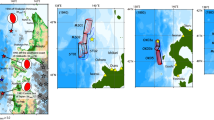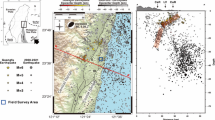Abstract
Recently an earthquake sequence occurred in Haenam, southwestern part of the Korean Peninsula. Earthquake swarms are not unusual in the western region of Korea, which already experienced comparable series of earthquakes before the Haenam earthquake: in the Boryeong offshore (2013) and Baekryeong Island (2013 and 2019) regions. The ML 3.1 earthquake occurred 21km WNW of Haenam on May 3, 2020 and the earthquake sequence occurred from April 26 to May 9 intensively. For two weeks, a dozen small foreshocks preceded the mainshock and more aftershocks occurred. In this paper, relocation of events with focal mechanisms based on the seismicity of the 2020 Haenam earthquake sequence is proposed. The distribution of earthquake sequence in Haenam area is WNW-ESE direction, which is approximately parallel to the fault plane solutions of events with ML ≥ 2.0 indicating strike-slip faults. The sequential events concentrate within the elliptical area of about 0.18 km2 on the surface and the focal depth distributions show some variations between 19.6 km and 21.6 km for different velocity models but their ranges are within about 500–600 m. The depth variations for different models can be due to the different boundary depths between upper and lower crusts. Based on a comparison of the earthquake swarms in the western region of the Korean Peninsula, this study provides seismological information for understanding the seismotectonic structures in the Korean Peninsula.
Similar content being viewed by others
References
Baag, C.-E., Shin, J.S., Chi, H.C., Kang, I.B., and Ryoo, Y., 1998, Fault plane solutions of the December 13, 1996 Yeongweol earthquake. Journal of Korean Geophysical Society, 1, 23–30. (in Korean with English abstract)
Chang, S.-J. and Baag, C.-E., 2006, Crustal structure in southern Korea from joint analysis of regional broadband waveforms and travel times. Bulletin of the Seismological Society of America, 96, 856–870.
Choi, H., Hong, T.-K., He, X., and Baag, C.-E., 2012, Seismic evidence for reverse activation of a paleo-rifting system in the East sea (Sea of Japan). Tectonophysics, 572–573, 123–133.
Chung, T.W. and Kim, W., 2000, Fault plane solutions for the June 26, 1997 Kyong-ju Earthquake. Journal of Korean Geophysical Society, 3, 245–250. (in Korean with English abstract)
Hahm, I.-K., Jeon, Y., Lee, J., Park, S., and Park, S., 2014, Historical earthquake records in Korea. Korea Meteorological Administration, Seoul, 67 p.
Hong, T.-K., 2010, Lg attenuation in a region with both continental and oceanic environments. Bulletin of the Seismological Society of America, 100, 851–858.
Hong, T.-K., Baag, C.-E., Choi, H., and Sheen, D.-H., 2008, Regional seismic observations of the 9 October 2006 underground nuclear explosion in North Korea and the influence of crustal structure on regional phases. Journal of Geophysical Research, 113, B03305. doi: https://doi.org/10.1029/2007JB004950
Hong, T.-K. and Choi, H., 2012, Seismological constraints on the collision belt between the North and South China blocks in the Yellow Sea. Tectonophysics, 570–571, 102–113.
Hong, T.-K., Lee, J., and Houng, S.E., 2015, Long-term evolution of intraplate seismicity in stress shadows after a megathrust. Physics of the Earth and Planetary Interiors, 245, 59–70.
Hong, T.-K., Lee, J., Kim, W, Hahm, I.-K., Woo, N.C., and Park, S., 2017, The 12 September 2016 ML 5.8 mid-crustal earthquake in the Korean Peninsula and its seismic implications. Geophysical Research Letter, 44, 3131–3138.
Hong, T.-K., Park, S., Lee, J., Chung, D., and Kim, W., 2020, One-off deep crustal earthquake swarm in a stable intracontinental region of the southwestern Korean Peninsula. Physics of the Earth and Planetary Interiors, 308, 106582.
Kang, T.-S. and Baag, C.-E., 2004, The 29 May 2004, Mw = 5.1, offshore Uljin earthquake, Korea. Geosciences Journal, 8, 115–123.
Kennett, B.L.N. and Engdahl, E.R., 1991, Traveltimes for global earthquake location and phase identification. Geophysical Journal International, 105, 429–465.
Kim, S.K. and Jung, B.H., 1985, Crustal structure of the southern part of Korea. Journal of the Korean Institute of Mining Geology, 18, 151–157. (in Korean with English abstract)
Kim, M.-C., Jung, S., Yoon, S., Jeong, R.-Y., Song, C.W., and Son, M., 2016, Neotectonic crustal deformation and current stress field in the Korean Peninsula and their tectonic implication: a review. Journal of the Petrological Society of Korea, 25, 169–193. (in Korean with English abstract)
Kim, S., Rhie, J., and Kim, G., 2011, Forward waveform modeling procedure for 1-D crustal velocity structure and its application to the southern Korean Peninsula. Geophysical Journal International, 185, 453–468.
Klein, F.W., 2002, User’s Guide to HYPOINVERSE-2000, a Fortran Program to Solve for Earthquake Locations and Magnitudes. Open-file report 2002–171, U.S. Geological Survey, Reston, 123 p.
Park, J.-C., Kim, W, Chung, T.W., Baag, C.-E., and Ree, J.-H., 2007, Focal mechanisms of recent earthquakes in the southern Korean Peninsula. Geophysical Journal International, 169, 1103–1114.
Snoke, J.A., Munsey, J.W., Teague, A.G., and Bollinger, G.A., 1984, A program for focal mechanism determination by combined use of polarity and SV-P amplitude ratio data. Earthquake Notes (Abstract), 55, 15.
Son, M., Shin, J.S., Kim, G., and Cho, C.S., 2015, Epicenter relocation of two 2013 earthquake sequences in the Yellow Sea, Korea, using traveltime double-differences and Lg-wave cross-correlation. Geosciences Journal, 19, 295–303.
Acknowledgments
We would like to express our gratitude to Korea Institute of Geoscience and Mineral Resources, Korea Institute of Ocean Science and Technology, Pusan National University to provide the seismic data. This study was supported by the “Development of earthquake, tsunami, volcano monitoring and prediction technology (KMA1365003180)” project of the Korea Meteorological Administration.
Author information
Authors and Affiliations
Corresponding author
Additional information
Publisher’s Note
Springer Nature remains neutral with regard to jurisdictional claims in published maps and institutional affiliations.
Supplementary Material A
Rights and permissions
About this article
Cite this article
Lee, J., Cho, S., Ahn, JK. et al. Seismicity of the 2020 ML3.1 Haenam earthquake and its sequence in South Korea. Geosci J 25, 9–17 (2021). https://doi.org/10.1007/s12303-020-0047-2
Received:
Accepted:
Published:
Issue Date:
DOI: https://doi.org/10.1007/s12303-020-0047-2




